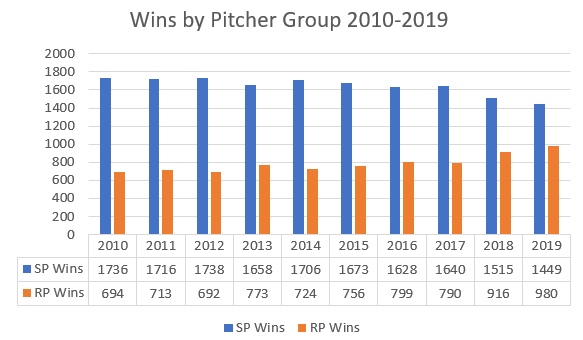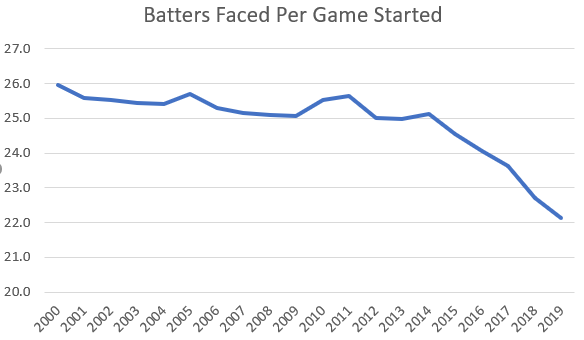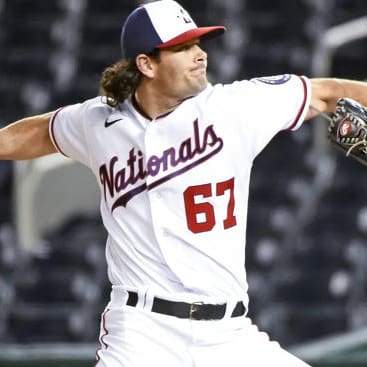This article is part of our Collette Calls series.
I had a radio appearance a few days back in Orlando where I said the 2020 season was going to be a tough one for baseball traditionalists because the season is introducing a high volume of change all at once. The season is essentially being treated as a labratory of sorts to try out a few changes that have been discussed over the years such as the Universal DH, expanded rosters, changing the extra inning rules and adjusting divisions.
Those reading this who consider themselves traditionalists likely will struggle with this abbreviated season as well. It is one thing to look at a league that might have recently migrated from a standard 5x5 format to substitute quality starts and feel pity given the winner of that category may be a single digit number in a single-league format. However, even the traditional 4x4 or 5x5 formats will be impacted this season by a new utilization of pitching. Don't believe me? Consider the following newsbits mined from Jeff Zimmerman's Mining the News column at Fangraphs:
- The Pirates will "probably be a tad more creative" with their fifth spot and look to implement a piggyback system to begin the season. Derek Shelton saw first hand how creative utilization of pitching can work in Tampa Bay, so this is not a new concept for him.
- The Giants are "ready to get weird" and have a plethora of veteran intriguing arms to piecemeal an interesting staff
- Atlanta too is looking at
I had a radio appearance a few days back in Orlando where I said the 2020 season was going to be a tough one for baseball traditionalists because the season is introducing a high volume of change all at once. The season is essentially being treated as a labratory of sorts to try out a few changes that have been discussed over the years such as the Universal DH, expanded rosters, changing the extra inning rules and adjusting divisions.
Those reading this who consider themselves traditionalists likely will struggle with this abbreviated season as well. It is one thing to look at a league that might have recently migrated from a standard 5x5 format to substitute quality starts and feel pity given the winner of that category may be a single digit number in a single-league format. However, even the traditional 4x4 or 5x5 formats will be impacted this season by a new utilization of pitching. Don't believe me? Consider the following newsbits mined from Jeff Zimmerman's Mining the News column at Fangraphs:
- The Pirates will "probably be a tad more creative" with their fifth spot and look to implement a piggyback system to begin the season. Derek Shelton saw first hand how creative utilization of pitching can work in Tampa Bay, so this is not a new concept for him.
- The Giants are "ready to get weird" and have a plethora of veteran intriguing arms to piecemeal an interesting staff
- Atlanta too is looking at some piggybacking for their pitching, but with more than just the final spot in the rotation. The expanded rosters in the first few weeks of the season makes this easier to do.
- The Padres are going to keep their starters on a short leash.
- The Twins are openly discussing taking advantage of the expanded rosters to get some bulk work from the starting pitching candidates that don't make the final rotation. They have the depth to take advantage of this.
- Joe Maddon is on record talking about using a quicker hook with the shorter schedule increasing the importance of every game.
- The Orioles hope to get their starting pitchers to the 85-pitch range by late July.
Simply put, the wins category is going to be greatly impacted this season by the utilization of starting pitchers and expanded rosters and we should do what we can to proactively plan for this impact to the category.
Starting pitchers have always amassed more wins than their relief counterparts, and the two totals have never come close to equaling one another, though the trend has headed in that direction the last two seasons:

Sixty-seven to 72 percent of wins went to starting pitchers from 2010 through the 2017 season, but recent seasons has seen that share lessening. The opener made its debut in late May 2018 when Sergio Romo started a game against the righty-heavy Angels lineup. Other clubs took notice and used the strategy later in 2018 and leveraged it a bit more this past season. The increased utilization of the opener resulted in a noticeable loss of wins going to starters as starters garnered 62 percent of wins in 2018 and just 60 percent of wins in 2019.
One may opine that changing from wins to quality starts (in a normal season) fixes this volatility in wins, but notice the trend on batters faced by starting pitchers in the graph below:

The average outing now is essentially two and a half times through the lineup where the average starting pitcher is being pulled after getting into trouble when facing the heart of the lineup for a third time. In 2020, we should expect that trend to continue for many starting pitchers, who may not even get to a third time through the order with many clubs openly discussing unique utilization of their pitching staffs.
A quality start needs a minimum 18 batters, and even that requires perfection in execution. Aces, in a normal season, have enhanced value because of this, and that even holds true in this abbreviated season assuming aces are excluded any special treatment or utilization by their managers in 2020. We can assume aces will do what they normally do, but we honestly have no baseline to look at when factoring in workload changes. We also do not know if the front office will mandate specific utilization with an eye toward the future, or if a team(s) will go for the quick cash grab and go all in on the short-season pot. My local NL league, which has been a quality start league the previous two seasons, just adjusted to QS+W for 2020, and maybe even beyond.
The data is staring us in the face; the change that some have said is coming this year was already underway. The shortened season will simply accelerate where the league has quietly been heading the last two seasons. Most reading this article have already drafted the teams they'll use this season, but it is not too late to tweak rosters to reflect the new reality of the 2020 pitching landscape. Below are some of the pitchers who could have hidden value in the new 2020 landscape.
Tyler Mahle - Mahle is projected to work out of the bullpen for Cincinnati, and that is not a bad thing. Mahle has started all 52 games in which he has appeared in his major league career, but has a 4.88 ERA to show for it. Mahle had a 23 percent strikeout rate along with a 17 percent K-BB% last season, but a 1.31 WHIP and a 1.74 HR/9 does not make for a good starting pitcher. Mahle had the worst wOBA of all NL starters last year for starters allowed to remain in the game after 18 batters faced. His .414 wOBA was only topped by Aaron Sanchez's .419. Mahle worked on his slider this spring/summer to give him two breaking balls along with his fastball and serviceable changeup. He had a 3.58 ERA, a 1.20 WHIP and a 26 percent strikeout rate last year the first two times through the order. Those numbers would play up for him in relief, either as a bulk guy if the team used an opener, or as a multi-inning reliever.
Trevor Richards - Richards going to Tampa Bay is in a perfect place to use his talents for this type of season. Richards mostly fastball and changeups with breaking balls to keep hitters honest. His first two times through the order in 2019, he had a 2.98 ERA, a 1.25 WHIP and struck out 23 percent of the hitters he faced and held hitters to a .231 average. When left in, that opponents' average jumped nearly 100 points and his ERA more than tripled to 9.13. Richards could easily be a bulk guy behind an opener or a 2-3 inning reliever a couple times a week and in position to pick up wins much like Ryan Yarbrough has the past two seasons.
Jeff Samardzija - Samardzija had a 2.73 ERA, a 1.07 WHIP and a 19 percent strikeout rate his first two times through the order last season in his first full season back from injury. When he was left in longer than that, those same metrics were 6.45, 1.27 and 18 percent. If the Giants are truly "ready to get wild," perhaps they will not leave Shark out there to soak up innings and will try to set him up for more success. Meanwhile, teammate Kevin Gausman is being miscast as a starter in the Giants rotation where his two-pitch combination is best suited for a single time through the order. Perhaps the tandem of Samardzija and Gausman in a single game would be more intriguing than either guy being overexposed.
Vince Velasquez - Velasquez is not assured of a spot in the rotation, and that may not be a bad thing. He worked on his changeup in the offseason, but his path to value may just be as a longer reliever. Velasquez held hitters to a .235 average last season while striking out 28 percent of the hitters he faced the first two times through the order. Despite those good numbers, he had a 4.20 ERA thanks to some gopheritis (1.6 HR/9). If that can normalize, and the changeup comes back, he could work out nicely out of the pen as a multi-inning reliever or as a starter with a quick hook. Kapler did not use a quick hook with him last season, and the 10.95 ERA and .435 opponents' average in the TTOP show that.
Matt Strahm - Strahm was already working in a swingman role, but in a very deep San Diego pitching staff, he should be able to focus on a role out of the pen. In each of the last two seasons, Strahm has a 20 percent K-BB% the first time through a batting order, and last year's .255 opponents' average against was his highest of four seasons. Strahm has the stuff to go a second time through, but on this staff, he does not need to. He could come in and work 2-3 times a week in multiple innings and be well positioned for some decisions while helping you in strikeouts and ratios.
Felix Pena - Pena has worked 90-plus innings each of the last two seasons with the Angels, but last year did most of it in relief. Joe Maddon has talked about stretching him out, but perhaps the better path could be turning him into another Yusmeiro Petit and using him frequently in short bunches. Last season, Pena had a 2.98 ERA, a .178 opponents' average and a 25 percent K-BB% his first time through a batting order. His second time through, those measures rose to 6.05, .242 and 12 percent respectively. Pena being stretched out may have more to do with him working more frequently rather than working deeper into games. As the second guy in behind Maddon's supposed quick hook, Pena could be in line to get some decisions in innings 5-7.
Collin McHugh - McHugh should be viewed in a similar light. Houston moved him around a bit, but last season, McHugh had a 2.96 ERA, a .201 opponents' average and a 22 percent K-BB%. He had similar numbers in 2018 as well. The numbers drop off a bit the second time through, but Boston may best served using McHugh as a one-time through guy given he is both coming off injury and has already been paid for the year. The attrition to Boston's staff might not permit the Red Sox to use him in the role, but if they can use an opener in front of him, McHugh becomes a sneaky play on the cheap.










